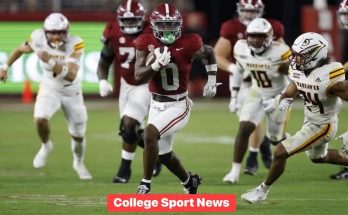Arch Manning, the quarterback for the Texas Longhorns, faced a rocky start to his season with a difficult outing against the defending national champions, Ohio State. The game, highly anticipated by fans and analysts alike, saw Manning struggle to find his rhythm, and the Longhorns ultimately fell short in a hard-fought battle. However, the response from Manning in the very next game against San Jose State has sparked renewed optimism and excitement among Texas supporters, raising questions about whether the young quarterback has fully regained his form and confidence. The first half of the San Jose State matchup was nothing short of spectacular for Manning, as he demonstrated poise, precision, and a command of the offense that had been glimpsed in flashes during his freshman campaign. In the opening 30 minutes, Manning threw for 180 passing yards, completing a series of impressive drives that highlighted both his accuracy and his ability to read defenses. More importantly, he accounted for four touchdowns, a remarkable feat that put the Longhorns firmly in control of the game and signaled to fans that he may indeed be back in action at a high level. What made Manning’s performance so impressive was not just the sheer volume of yards or the touchdowns, but the manner in which he orchestrated the offense. Each play seemed calculated and deliberate, demonstrating a growing maturity in his approach to the quarterback position. He showcased a mix of short, precise passes and longer, more ambitious throws, keeping the San Jose State defense off balance throughout the half. His ability to quickly process information, anticipate the defensive schemes, and make adjustments on the fly was evident, suggesting that the tough experience against Ohio State may have been a valuable learning moment rather than a setback. The Longhorns’ offensive line also played a crucial role in Manning’s resurgence. After struggling with protection issues in previous games, the line provided consistent support, giving Manning the time and space needed to execute plays effectively. This collaboration between the quarterback and his line highlighted the importance of cohesion and communication within the team, underscoring that Manning’s performance was not an isolated display of talent but a reflection of improved teamwork and preparation. Additionally, the receivers stepped up in a major way, capitalizing on Manning’s precision and making critical catches that extended drives and converted key third downs. The connection between Manning and his primary targets was evident, as timing routes and situational awareness were executed nearly flawlessly. The chemistry on display reinforced the notion that Manning thrives in an environment where trust and familiarity with his teammates are established, allowing him to maximize his natural abilities. Fans and analysts alike have noted the significance of this performance for the Longhorns’ season trajectory. After a challenging start, the momentum generated by Manning’s half against San Jose State could serve as a catalyst for the team’s overall confidence and strategy moving forward. College football seasons are often defined by turning points, and this game may represent a crucial inflection point for both Manning and Texas. Beyond the statistics and touchdowns, Manning’s demeanor on the field also suggested a renewed sense of leadership and resilience. Following the Ohio State loss, there was speculation about his ability to rebound and lead the team effectively, but his composure in high-pressure situations against San Jose State seems to have quelled many of those doubts. Leadership at the quarterback position is not solely about performance metrics; it also involves inspiring teammates, making decisive plays under stress, and maintaining focus amidst adversity. Manning’s display in this game indicated that he is capable of embodying these qualities, which bodes well for the Longhorns as they navigate the remainder of the season. Moreover, Manning’s improvement is likely to have a ripple effect across the team. Confidence is contagious in sports, and seeing their quarterback play with such assurance can energize other players, encouraging better execution on both sides of the ball. The defense, for example, may feel less pressure knowing the offense can reliably score, leading to more aggressive and effective defensive plays. Similarly, the running game may benefit as opposing defenses adjust to account for Manning’s passing prowess, opening up lanes and opportunities for the Longhorns’ backs. Analysts have also pointed out that Manning’s resurgence may influence the strategic approach of the coaching staff. With a quarterback capable of delivering big plays and maintaining consistency, offensive coordinators can expand the playbook, incorporate more complex schemes, and take calculated risks that were previously considered too high-stakes. This flexibility can make the Longhorns’ offense more unpredictable and difficult to defend, giving Texas a competitive edge in upcoming matchups. While the performance against San Jose State was undeniably impressive, it is important to contextualize it within the broader scope of college football. Consistency is key, and Manning will need to sustain this level of play against stronger defenses and higher-ranked opponents to solidify his status as a top-tier quarterback. The upcoming games will test his ability to adapt, maintain focus, and continue executing under varying conditions. That said, the strong first half against San Jose State has certainly reset expectations and provided a tangible example of Manning’s potential when operating at full capacity. The response from fans on social media and within the college football community has been overwhelmingly positive. Highlights of his passing yardage and touchdowns circulated widely, with commentators praising both his athletic ability and his mental acuity on the field. This public recognition not only boosts Manning’s confidence but also raises the profile of the Texas Longhorns, attracting attention from prospective recruits, media outlets, and rival teams alike. In terms of long-term implications, Manning’s return to form could have a significant impact on the trajectory of the Longhorns’ season. A quarterback performing at this level increases the team’s likelihood of competing for conference titles, bowl games, and national recognition. Additionally, individual accolades and NFL draft considerations may become relevant as Manning continues to demonstrate his capabilities and leadership qualities. The experience against Ohio State, rather than being a permanent setback, may have served as a crucible for growth. Facing a high-caliber opponent early in the season can expose weaknesses, illuminate areas for improvement, and provide valuable lessons that fuel future success. Manning’s ability to respond positively to such challenges highlights resilience—a trait often cited as essential for elite athletes—and suggests that he has the mental toughness required to navigate the pressures of collegiate competition. In conclusion, Arch Manning’s performance in the first half against San Jose State offers compelling evidence that he is back in action and ready to lead the Texas Longhorns with confidence and skill. Throwing for 180 passing yards and four touchdowns in a single half is a remarkable achievement, but the broader implications extend beyond statistics. His poise, leadership, adaptability, and ability to inspire his teammates all point to a quarterback operating at a high level, poised to drive the Longhorns forward through the remainder of the season. While the challenges of college football are relentless and the coming games will test Manning’s consistency and resilience, the San Jose State performance provides both a beacon of hope and a blueprint for success. Fans and analysts alike will be watching closely, but for now, it seems that Arch Manning has not only recovered from a tough outing against Ohio State but has also signaled that he is ready to reclaim his role as the driving force behind the Texas Longhorns’ offense. The excitement generated by this game may well be the spark the team needs to elevate their play, build momentum, and pursue their ambitions with renewed vigor. With his arm strength, football IQ, and demonstrated ability to perform under pressure, Manning is well-positioned to make a significant impact and lead the Longhorns toward a successful season, leaving no doubt that the young quarterback is very much back in action.



